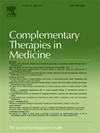Effects of acupuncture-related treatments on blood lipid levels in patients with coronary heart disease: A comprehensive review and network meta-analysis
IF 3.3
3区 医学
Q1 INTEGRATIVE & COMPLEMENTARY MEDICINE
引用次数: 0
Abstract
Background
Dyslipidemia is considered a substantial risk factor for coronary heart disease (CHD). Blood lipid levels in patients with CHD influence cardiovascular events. Therefore, it is critical to monitor and control these levels. As a traditional, complementary alternative therapy, acupuncture regulates blood lipid levels in patients with CHD. More acupuncture-related treatments are currently available. However, systematic reviews or evidence-based summaries have yet to be conducted.
Methods
This study included a randomized controlled trial of the effects of acupuncture-related therapies on blood lipid levels in CHD patients. The outcome indicators were changes in the TC, TG, LDL-C, and HDL-C levels. Two independent reviewers extracted data from PubMed, Web of Science, EMBASE, Cochrane Library, Medline (Ovid), China Knowledge Network, Wanfang, Vipshop, and SinoMed databases until January 7 2024. The literature quality was assessed using RevMan 5.4.1. The data were analyzed using the Frequentist network meta-analysis with STATA 15.1 software. Network meta-analysis was used to compare direct and indirect evidence, and a cumulative ranking curve (SUCRA) was used to evaluate the curative effect. For consistency, global inconsistency and ring-inconsistency test evaluations were used. The Cochrane bias risk assessment tool was used to assess quality.
Results
Fourteen studies with 1416 patients were included in the study. The evidence network shows that there are many studies on acupuncture and warm acupuncture. According to the direct comparison and SUCRA ranking, acupuncture reduced TC [− 1.82 (− 3.36, − 0.28)], heat-sensitized moxibustion lowered TG [− 2.12 (− 3.55, − 0.69)], LDL-C [− 1.37 (− 2.09, − 0.66)], and increased HDL-C [0.87 (0.52, 1.22)]. These two interventions were the first in the SUCRA ranking. The inconsistency analysis revealed that direct evidence corresponded with indirect evidence. There were some methodological defects in the included studies, and some studies did not implement blinding methods, had small sample sizes or other problems.
Conclusions
Heat-sensitized moxibustion significantly lowered TG and LDL-C levels and elevated HDL-C levels. Acupuncture significantly reduced TC levels. Heat-sensitized moxibustion is a more effective intervention than other acupuncture-related treatments for regulating blood lipid levels in patients with CHD. However, this study has several limitations, and clinical practice should be performed as needed.
针灸相关疗法对冠心病患者血脂水平的影响:综合综述和网络荟萃分析。
背景:血脂异常被认为是冠心病(CHD)的重要危险因素。冠心病患者的血脂水平会影响心血管事件的发生。因此,监测和控制血脂水平至关重要。作为一种传统的辅助替代疗法,针灸可调节冠心病患者的血脂水平。目前有更多与针灸相关的治疗方法。然而,系统性回顾或基于证据的总结尚未开展:本研究包括一项针灸相关疗法对冠心病患者血脂水平影响的随机对照试验。结果指标为 TC、TG、LDL-C 和 HDL-C 水平的变化。两位独立审稿人从PubMed、Web of Science、EMBASE、Cochrane Library、Medline (Ovid)、中国知网、万方、唯品会和SinoMed等数据库中提取数据,截止日期为2024年1月7日。文献质量采用 RevMan 5.4.1 进行评估。数据采用 STATA 15.1 软件的 Frequentist 网络荟萃分析法进行分析。网络荟萃分析用于比较直接和间接证据,累积排名曲线(SUCRA)用于评估疗效。在一致性方面,采用了总体不一致性和环形不一致性检验评价。评估质量时使用了 Cochrane 偏倚风险评估工具:研究共纳入了 14 项研究,1416 名患者。证据网络显示,关于针灸和温针灸的研究很多。根据直接比较和SUCRA排序,针灸降低TC [-1.82 (-3.36, -0.28)],热敏灸降低TG [-2.12 (-3.55, -0.69)]、LDL-C [-1.37 (-2.09, -0.66)],提高HDL-C [0.87 (0.52, 1.22)]。这两项干预措施在 SUCRA 排名中位居第一。不一致性分析显示,直接证据与间接证据一致。纳入的研究在方法上存在一些缺陷,有些研究没有采用盲法,样本量较小或存在其他问题:结论:热敏灸能显著降低 TG 和 LDL-C 水平,升高 HDL-C 水平。针灸能明显降低总胆固醇水平。在调节冠心病患者血脂水平方面,热敏灸比其他针灸相关疗法更有效。然而,本研究存在一些局限性,临床实践应根据需要进行。
本文章由计算机程序翻译,如有差异,请以英文原文为准。
求助全文
约1分钟内获得全文
求助全文
来源期刊

Complementary therapies in medicine
医学-全科医学与补充医学
CiteScore
8.60
自引率
2.80%
发文量
101
审稿时长
112 days
期刊介绍:
Complementary Therapies in Medicine is an international, peer-reviewed journal that has considerable appeal to anyone who seeks objective and critical information on complementary therapies or who wishes to deepen their understanding of these approaches. It will be of particular interest to healthcare practitioners including family practitioners, complementary therapists, nurses, and physiotherapists; to academics including social scientists and CAM researchers; to healthcare managers; and to patients. Complementary Therapies in Medicine aims to publish valid, relevant and rigorous research and serious discussion articles with the main purpose of improving healthcare.
 求助内容:
求助内容: 应助结果提醒方式:
应助结果提醒方式:


